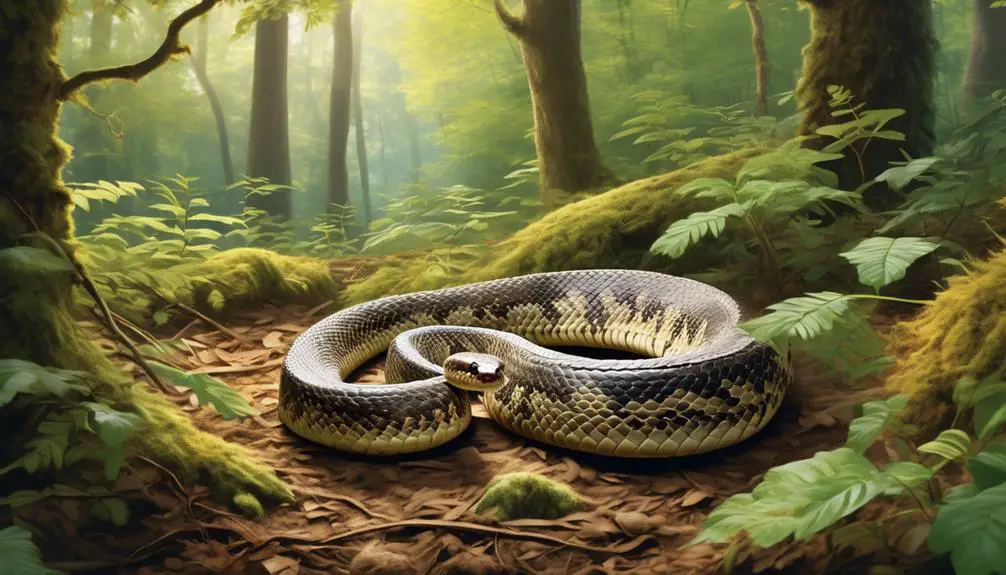Have you ever wondered what slithers in the depths of Indiana’s wilderness? Brace yourself, for the serpent-filled secrets of this region are about to be unveiled.
From venomous vipers with deadly fangs to harmless yet intriguing reptiles, Indiana is home to a diverse range of snake species. But tread carefully, for these cunning creatures may be lurking right under your nose.
So, prepare to embark on a journey through the hidden world of Indiana’s snakes, where danger and fascination intertwine in a delicate dance.
Table of Venomous Snakes in Indiana:
| Species | Description | Habitat | Distribution | Venom |
|---|---|---|---|---|
| Eastern Copperhead (Agkistrodon contortrix) | Copper-colored with hourglass markings, 20-30 inches long | Rocky outcroppings, woodpiles, and near water sources | Statewide, but more common in southern Indiana | Hemotoxic, causes pain, swelling, and bruising |
| Cottonmouth (Agkistrodon piscivorus) | Dark-colored with a white coloration on the inside of its mouth, 20-30 inches long | Near water sources, such as lakes, rivers, and swamps | Southern and southwestern Indiana | Hemotoxic, causes pain, swelling, and respiratory distress |
| Eastern Massasauga Rattlesnake (Sistrurus catenatus) | Gray or brown with a distinctive rattle on its tail, 18-30 inches long | Wetlands, such as marshes and swamps | Northern and central Indiana | Hemotoxic, causes pain, swelling, and respiratory distress |
| Timber Rattlesnake (Crotalus horridus) | Brown or gray with a distinctive rattle on its tail, 30-40 inches long | Forested areas, rocky outcroppings, and woodland edges | Southern and central Indiana | Hemotoxic, causes pain, swelling, and respiratory distress |
Note:
- Habitat: The habitats listed are general and may not be exhaustive, as snakes can be found in a variety of environments.
- Distribution: While these snakes can be found in the specified regions, their distribution may not be uniform throughout the region.
- Venom: The effects of the venom listed are general and may vary depending on the individual and the severity of the bite.
Non-Venomous Snakes in Indiana:
| Species | Scientific Name | Description | Habitat |
|---|---|---|---|
| Bullsnake | Pituophis catenifer | Brown or gray with yellow or white markings | Prairies, open fields, along fences |
| Common Garter Snake | Thamnophis sirtalis | Brown or green with stripes | Wetlands, near water, gardens |
| Eastern Garter Snake | Thamnophis sirtalis sirtalis | Brown or green with stripes | Wetlands, near water, gardens |
| Eastern King Snake | Lampropeltis getulus | Black with white or yellow markings | Wooded areas, rocky hillsides, near water |
| Milk Snake | Lampropeltis triangulum | Red, white, and black bands | Wooded areas, rocky hillsides, near water |
| Northern Water Snake | Nerodia sipedon | Brown or gray with darker blotches | Near water, wetlands, rocky areas |
| Queen Snake | Regina septemvittata | Gray or brown with darker stripes | Near water, wetlands, rocky areas |
| Ribbon Snake | Thamnophis sauritus | Brown or gray with darker stripes | Wetlands, near water, gardens |
| Western Ribbon Snake | Thamnophis proximus | Brown or gray with darker stripes | Wetlands, near water, gardens |
Please note that while this table provides a comprehensive list of snakes found in Indiana, it’s essential to remember that:
- It’s always best to exercise caution when dealing with snakes, and if you’re unsure about a snake’s identity, it’s best to consult a professional or leave it alone.
Remember to respect snakes and their habitats, and never attempt to handle or harm them.
Venomous Snakes in Indiana
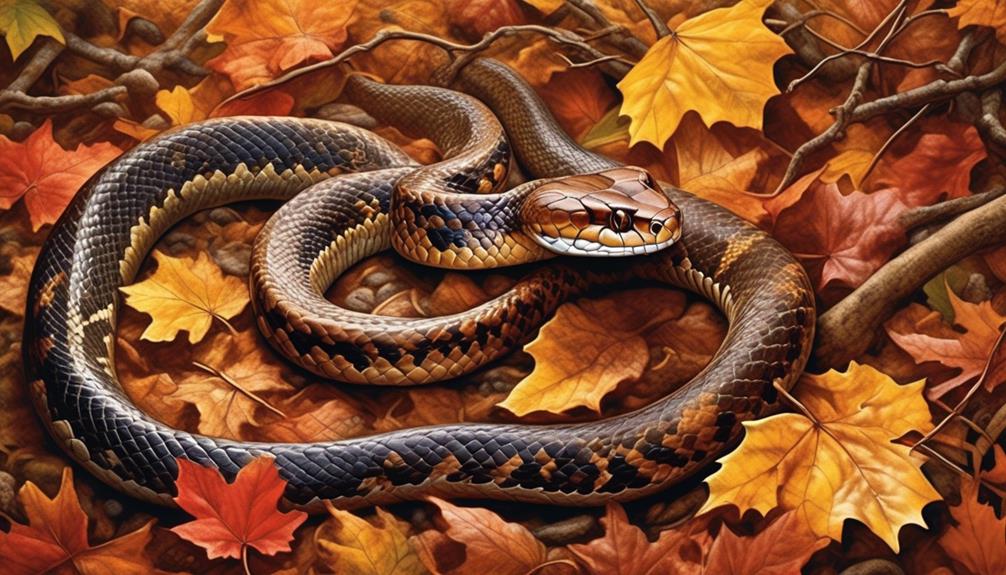
Indiana is home to several venomous snake species. One of these is the timber rattlesnake, also known as Crotalus horridus. This endangered species is mainly found in Brown County State Park and rarely bites humans. Instead, it prefers to rattle its tail as a warning to scare off attackers. The timber rattlesnake has highly toxic venom that can be fatal to humans, although there have been no recorded bites in Brown County State Park in the last 30 years.
Another venomous snake found in Indiana is the cottonmouth, scientifically known as Agkistrodon piscivorus leucostoma. This semi-aquatic snake is typically found in wet and damp environments. Its name ‘cottonmouth’ comes from the white color of the mucus lining inside its mouth. The western cottonmouth is usually around a meter in length and possesses venom that can be fatal to humans. However, deaths from its bites remain incredibly rare.
The eastern massasauga rattlesnake, or Sistrurus catenatus, is an endangered pit viper found across North America. It has a distinctive pattern of large black or brown patches on its body. The venom of the eastern massasauga rattlesnake is mainly used to capture prey, causing tissue destruction and internal bleeding. This snake is shy by nature and avoids confrontation with larger animals. Bites on humans usually occur through direct contact or mishandling.
Lastly, the northern copperhead, scientifically known as Agkistrodon contortrix mokasen, is found in southern areas of Indiana and across the eastern and southern United States. It’s typically a tanned brown color with distinctive markings. The northern copperhead is known for its relaxed nature and freezing in response to danger. While its bites are generally non-life threatening, they can cause swelling and permanent damage. Accidental stepping on frozen copperheads can be dangerous.
Timber Rattlesnake
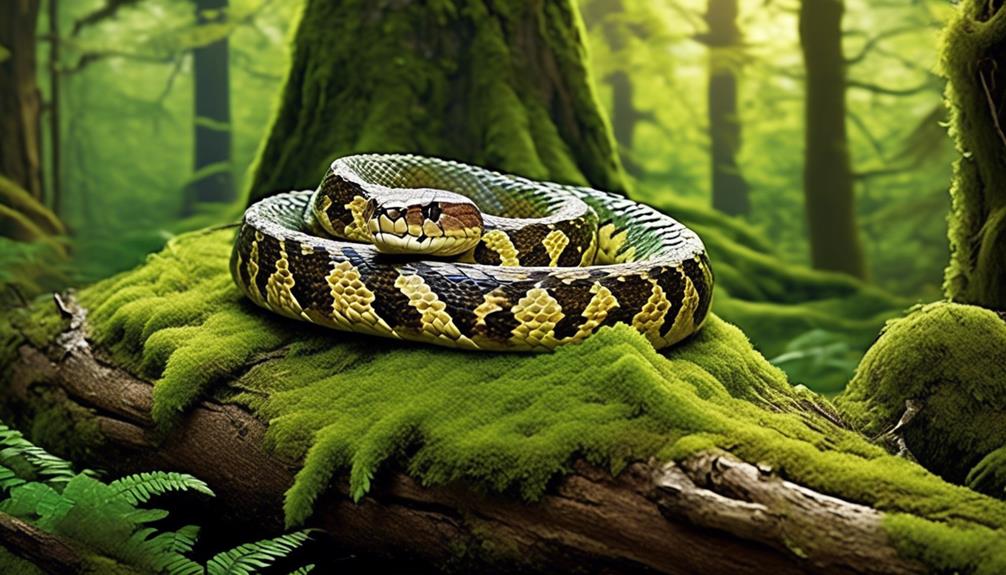
Now let’s talk about the Timber Rattlesnake, one of the venomous snakes found in Indiana.
This species is considered endangered in the state and is mainly found in Brown County State Park.
Timber Rattlesnakes are known for their rattling behavior, using it as a warning to scare off potential threats rather than biting.
However, their venom is highly toxic and can be fatal to humans, so it’s important to exercise caution when encountering this species.
Habitat and Behavior
The habitat and behavior of the timber rattlesnake, a venomous species found in Indiana, is characterized by its preference for wooded areas and its defensive nature. Timber rattlesnakes are typically found in forested regions with rocky outcrops, such as Brown County State Park in Indiana. They’re highly skilled climbers and can often be found basking on rocks or in the branches of trees.
These snakes are known for their distinctive rattling sound, which they use to warn potential predators or threats. Despite their venomous nature, timber rattlesnakes are generally non-aggressive towards humans and prefer to use their rattle as a deterrent. However, if provoked or threatened, they’ll defend themselves by striking and injecting their potent venom.
It’s important to exercise caution and give these snakes a wide berth if encountered in their natural habitat.
Venom and Potential Danger
With their preference for wooded areas and their defensive nature, it’s important to understand the venom and potential danger posed by timber rattlesnakes in Indiana.
Timber rattlesnakes are highly venomous and possess a potent toxin that can be fatal to humans. Their venom is primarily used to capture prey, causing tissue destruction and internal bleeding.
While they rarely bite humans, they prefer to use their distinctive rattling sound as a warning to scare off attackers. It’s essential to exercise caution when encountering timber rattlesnakes in their habitat, as their bites can be life-threatening.
However, it’s worth noting that there have been no recorded bites in Brown County State Park, where they’re mainly found, in the last 30 years.
Cottonmouth
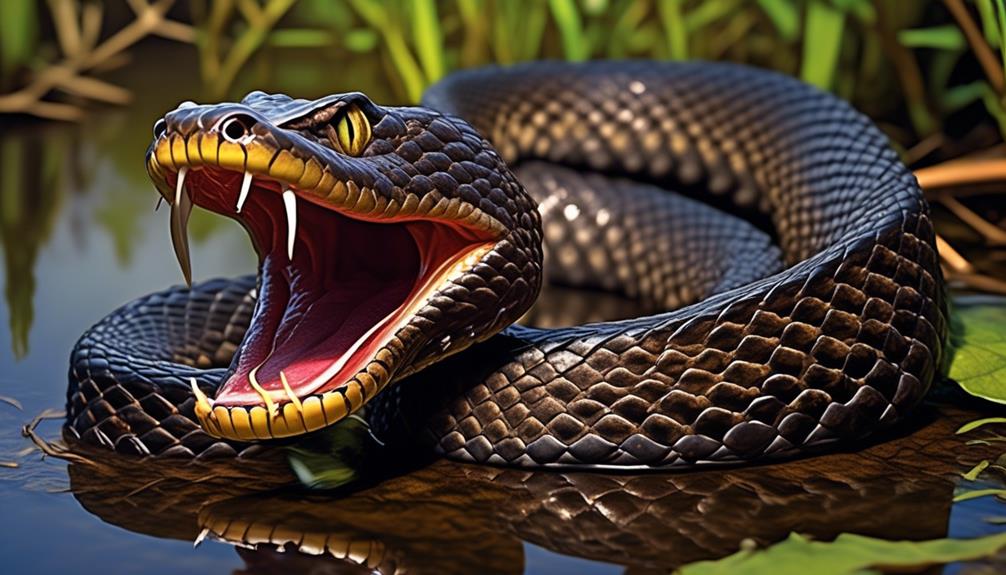
Found in wet and damp environments, the cottonmouth (Agkistrodon piscivorus leucostoma) is a semi-aquatic snake with venom that can be fatal to humans. Also known as the water moccasin, this snake gets its name from the color of the mucus lining inside its mouth, which appears white like cotton. The western cottonmouth can reach lengths of up to a meter and is typically dark brown or black, with a heavy body and a thick, triangular-shaped head.
This venomous snake is primarily found in the southern regions of the United States, including parts of Indiana. While deaths from bites are incredibly rare, it’s important to exercise caution when encountering a western cottonmouth. The venom of this snake is potent and can cause severe pain, swelling, and tissue damage. In some cases, if left untreated, the bite can be fatal.
Eastern Massasauga Rattlesnake
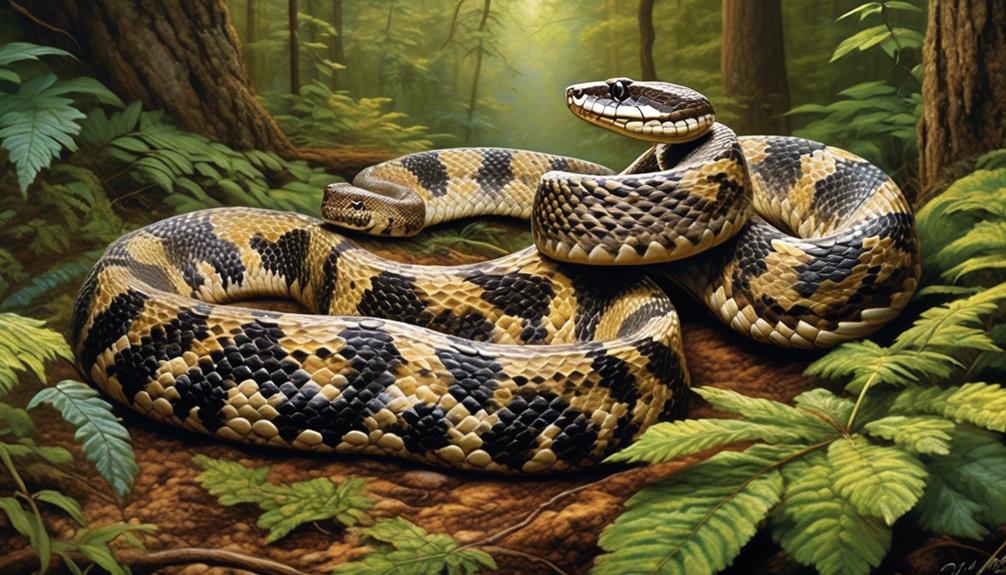
After discussing the western cottonmouth, it’s important to turn our attention to another venomous snake species found in Indiana: the Eastern Massasauga Rattlesnake. This endangered pit viper is known for its distinctive pattern of large black or brown patches and can be found across North America. The Eastern Massasauga Rattlesnake possesses venom mainly used to capture prey, causing tissue destruction and internal bleeding. However, it is shy by nature and avoids confrontation with larger animals, including humans. Bites on humans usually occur through direct contact or mishandling.
To provide more information about the Eastern Massasauga Rattlesnake, here is a table detailing some key characteristics of this species:
| Eastern Massasauga Rattlesnake | |
|---|---|
| Scientific Name | Sistrurus catenatus |
| Habitat | Wetlands, marshes, and swamps |
| Average Length | 2-3 feet |
| Diet | Small mammals, birds, frogs |
| Conservation Status | Endangered |
| Venomous | Yes |
| Venom Type | Hemotoxic |
| Venom Effects | Tissue destruction, internal bleeding |
| Human Interaction | Shy and avoids confrontation with humans |
It’s important to remember that although the Eastern Massasauga Rattlesnake is venomous, it generally prefers to avoid humans and will only bite if it feels threatened or cornered. If you encounter this snake in the wild, it’s best to give it a wide berth and allow it to move away on its own. If you are bitten by an Eastern Massasauga Rattlesnake, seek immediate medical attention as the venom can cause severe damage.
Northern Copperhead
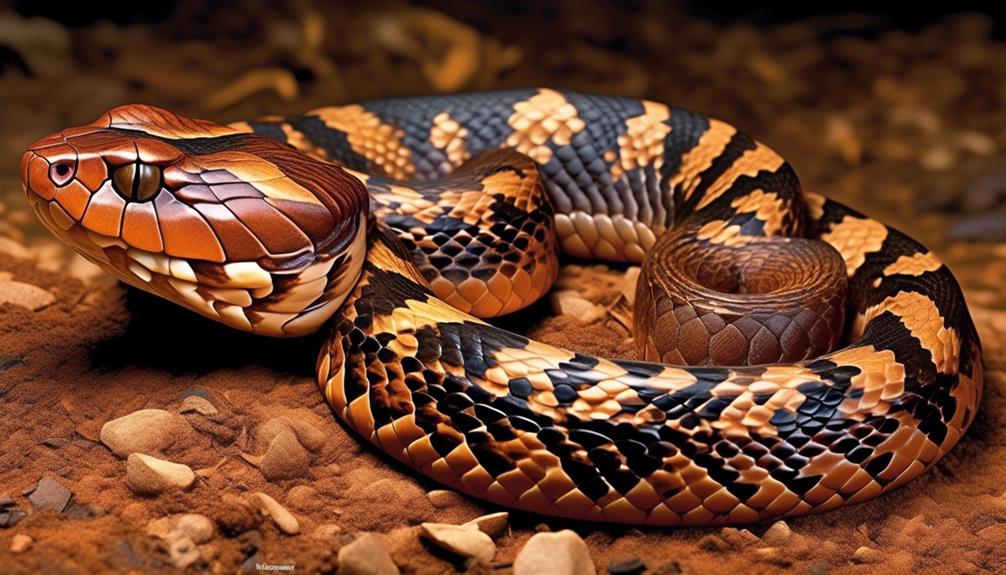
The Northern Copperhead, a venomous snake species found in southern areas of Indiana and across the eastern and southern United States, is known for its relaxed nature and freezing in response to danger. These snakes are typically a tanned brown color with distinctive markings that help them blend in with their surroundings. Although their bites are generally non-life threatening, they can cause swelling and permanent damage.
It’s important to be cautious when encountering a Northern Copperhead, as accidentally stepping on a frozen snake can be dangerous. Northern Copperheads are generally not aggressive towards humans and will only bite if they feel threatened or provoked. When confronted with danger, they’ve a unique defense mechanism of freezing in place, relying on their camouflage to go unnoticed. This behavior can make them difficult to spot and potentially increase the risk of accidental encounters.
If you do happen to come across a Northern Copperhead, it’s best to give the snake plenty of space and slowly back away. It’s important not to attempt to handle or capture the snake, as this can increase the risk of a bite. If you or someone else is bitten by a Northern Copperhead, it’s crucial to seek immediate medical attention.
Non-Venomous Snakes in Indiana
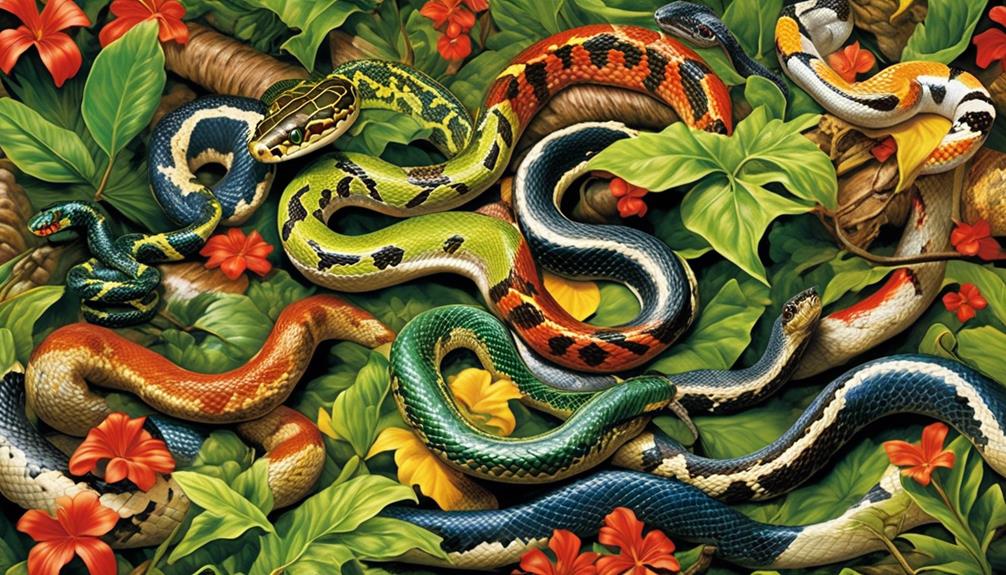
Non-venomous snakes in Indiana can be found in a variety of habitats and play important roles in the ecosystem. These snakes are harmless to humans and often misunderstood due to their resemblance to venomous species. Here are some non-venomous snakes found in Indiana:
| Snake | Characteristics |
|---|---|
| Northern brown snake (S. dekayi) | One of the most common snakes in Indiana. Found in a wide range of habitats. Harmless to humans. |
| Northern diamondback water snake (Nerodia rhombifer) | Resembles venomous species. Excellent swimmers and hunters. Harmless to humans. |
| Eastern garter snake (Thamnophis sirtalis sirtalis) | Common in Indiana. Plays an important role in controlling rodent populations. Harmless to humans. |
| Eastern milk snake (Lampropeltis triangulum) | Resembles venomous coral snake. Known for vibrant colors and patterns. Harmless to humans. |
These non-venomous snakes are essential for maintaining a balanced ecosystem. They help control rodent populations, which can be a nuisance to humans. Additionally, they serve as a food source for larger predators, contributing to the overall biodiversity of the region. It is important to remember that these snakes are harmless and should be respected and protected. If you encounter one in the wild, simply observe from a safe distance and appreciate the important role they play in the environment.
Northern Brown Snake
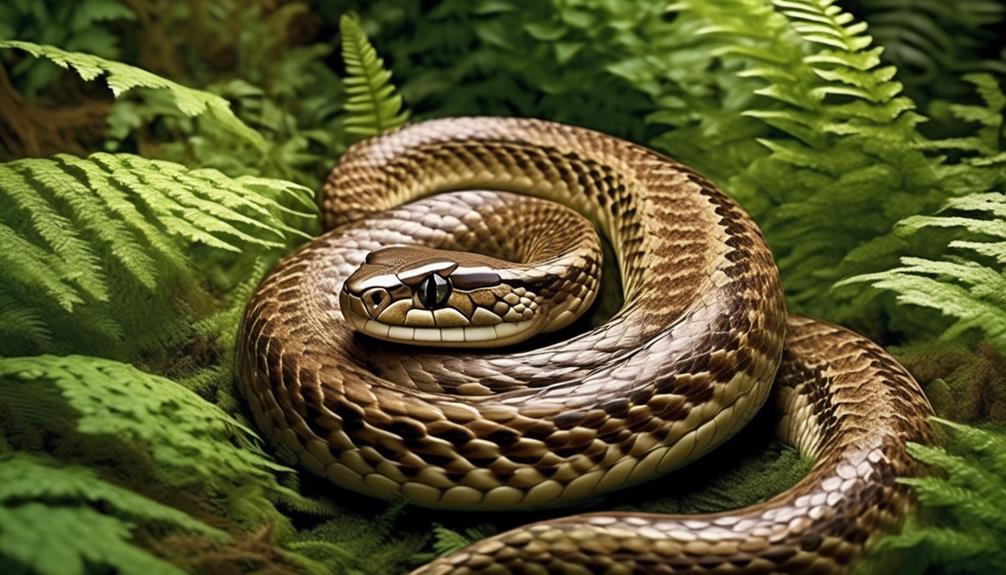
Northern Brown Snakes, one of the most common snakes in Indiana, are harmless to humans and can be found in a wide range of habitats. These non-venomous snakes, typically measuring around 12 inches in length, are widely distributed from Canada to Central America. They’ve smooth scales and a slender body, which allows them to navigate through various environments such as forests, grasslands, and wetlands.
Northern Brown Snakes are known to be docile and non-aggressive towards humans. They mainly feed on earthworms, slugs, and insects, making them beneficial to have in your garden as they help control pest populations. These snakes are also preyed upon by larger snakes in the wild.
When encountering a Northern Brown Snake, it’s best to observe from a safe distance and appreciate their presence in the ecosystem. They may try to escape or hide if they feel threatened, so it’s important to respect their space. Remember, these snakes pose no danger to humans and play a valuable role in maintaining a balanced ecosystem.
If you come across a Northern Brown Snake in your yard or while out exploring nature, take a moment to appreciate its beauty and importance in the natural world. By understanding and respecting these creatures, we can coexist peacefully and appreciate the diversity of wildlife in Indiana.
Northern Diamondback Water Snake
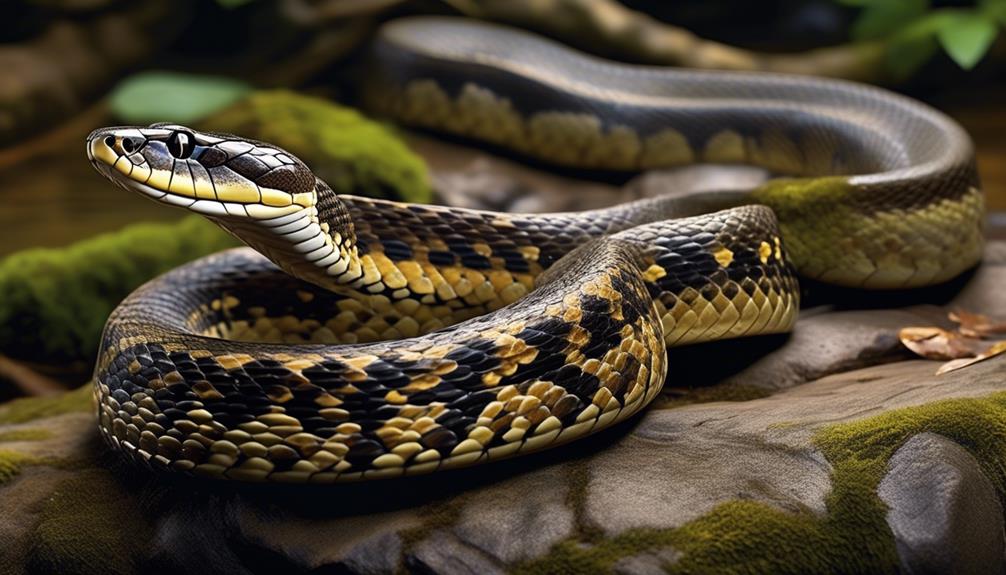
As we continue our exploration of Indiana’s diverse snake species, let’s turn our attention to the remarkable Northern Diamondback Water Snake.
This non-venomous snake is often mistaken for venomous species such as the timber rattlesnake or the western cottonmouth. However, it’s completely harmless to humans and shouldn’t be killed due to mistaken identity.
The Northern Diamondback Water Snake is an excellent swimmer and hunter, with sharp teeth that help it catch fish in its aquatic habitat. It prefers to live near large bodies of water undisturbed, making it commonly found in lakes, rivers, and marshes throughout Indiana.
With an average length of 2 to 3 feet, this snake has a slender body and a light brown or gray coloration with dark blotches along its back. Despite its resemblance to venomous species, the Northern Diamondback Water Snake is an important part of Indiana’s ecosystem and should be appreciated for its role in controlling fish populations and maintaining the balance of nature.
Eastern Garter Snake
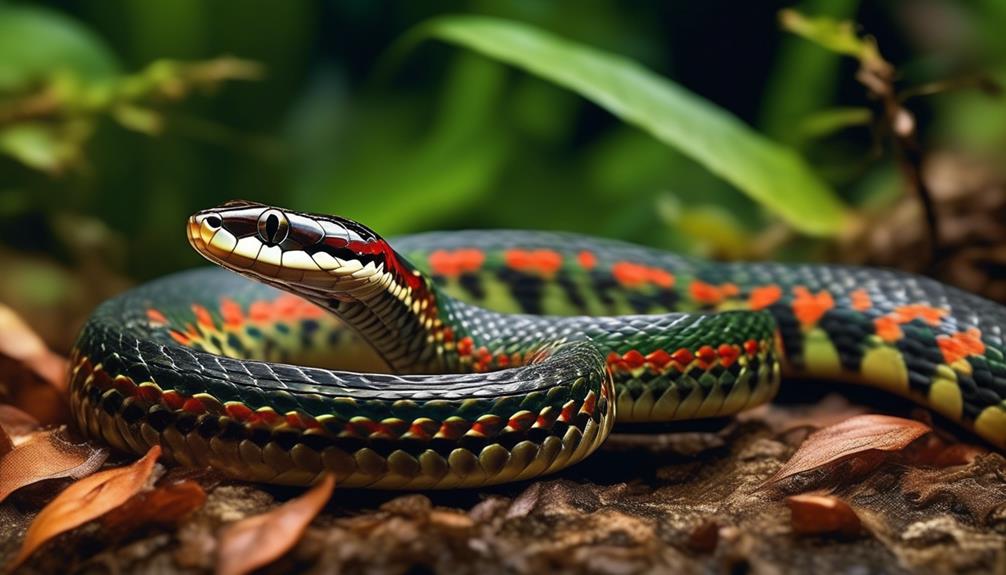
Now let’s turn our attention to the Eastern Garter Snake, a non-venomous species commonly found in Indiana.
These snakes are adaptable and can be found in a variety of habitats, including wetlands and forests.
Eastern Garter Snakes play an important role in controlling rodent populations, making them beneficial for the ecosystem.
The Eastern Garter Snake is known for its ability to adapt to different environments, making it a successful species in Indiana. It can be found in forests, where it climbs trees and shrubs to search for food. In wetlands, it is a skilled swimmer and hunter, preying on fish and amphibians. In grasslands, the snake basks in the sun to regulate its body temperature. It is also commonly found in gardens, where it helps control rodent populations. Finally, the Eastern Garter Snake thrives in farmlands, where it takes advantage of the abundance of small rodents.

Erzsebet Frey (Eli Frey) is an ecologist and online entrepreneur with a Master of Science in Ecology from the University of Belgrade. Originally from Serbia, she has lived in Sri Lanka since 2017. Eli has worked internationally in countries like Oman, Brazil, Germany, and Sri Lanka. In 2018, she expanded into SEO and blogging, completing courses from UC Davis and Edinburgh. Eli has founded multiple websites focused on biology, ecology, environmental science, sustainable and simple living, and outdoor activities. She enjoys creating nature and simple living videos on YouTube and participates in speleology, diving, and hiking.
- WILDLIFE THEMED T-SHIRTS
Cute Hedgehog Embroidered: Love Wildlife, Protect Nature Wildlife conservation tees
$35.00

